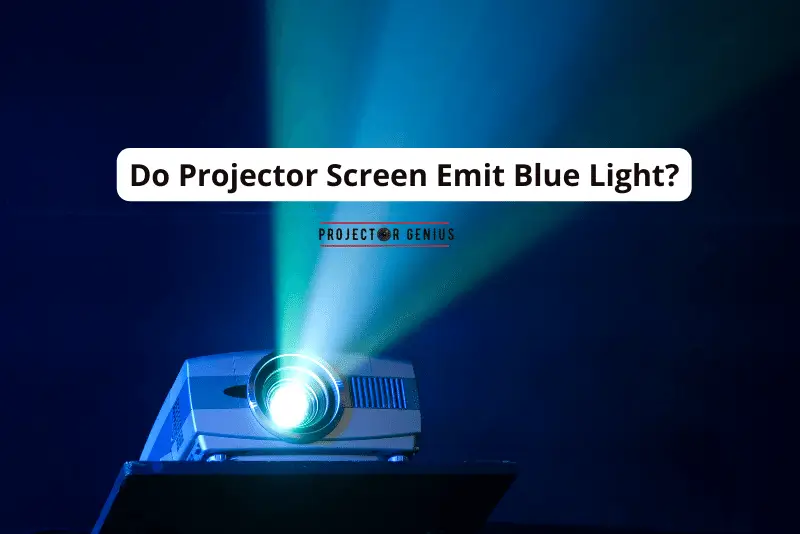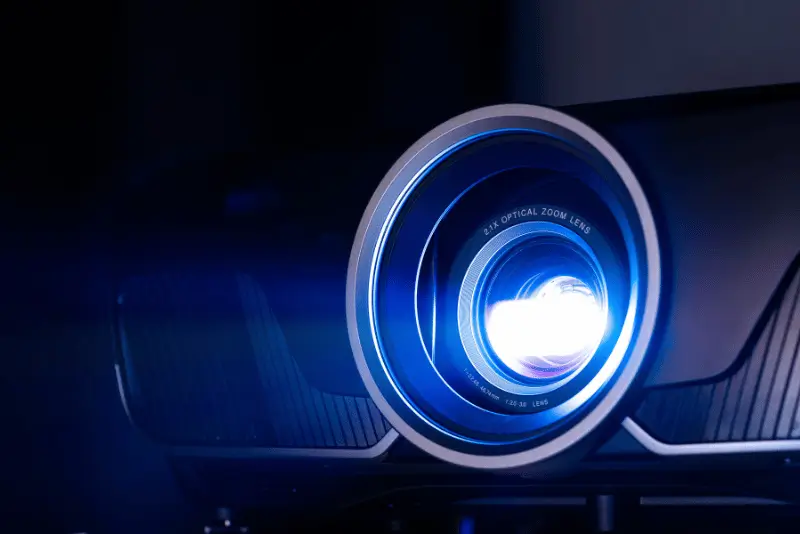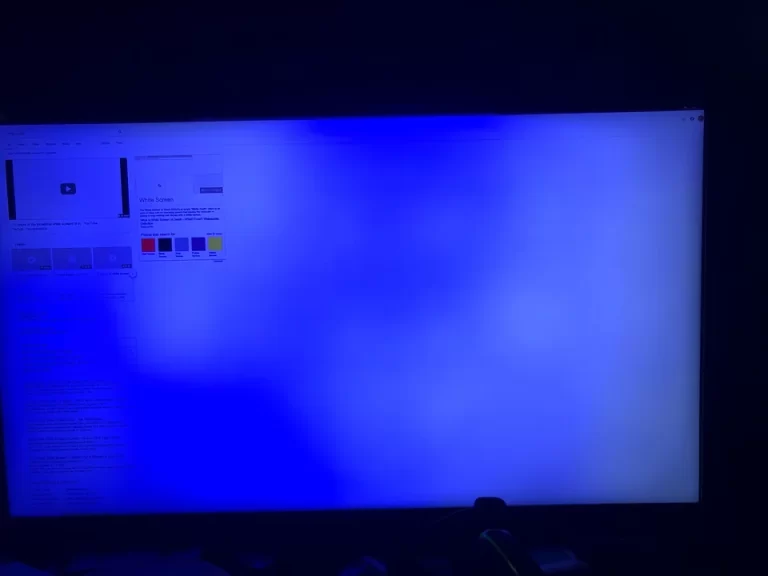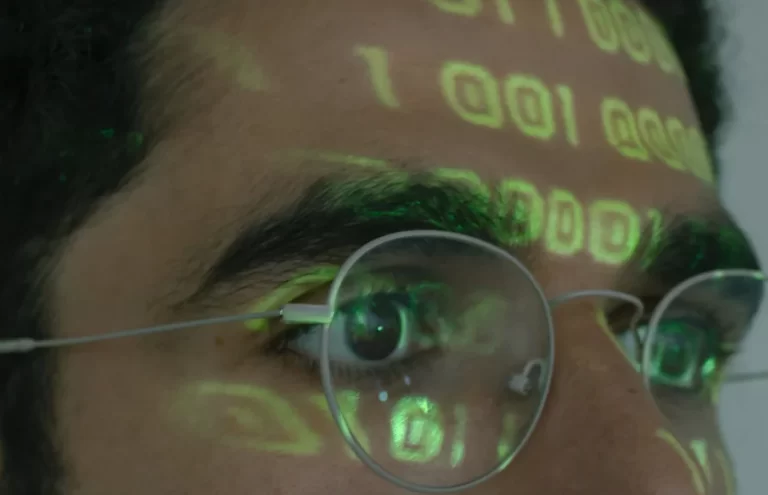Do Projector Screen Emit Blue Light? [How to Fix]
-
 Written by:
Kristy Roger
Written by:
Kristy Roger
- Last Updated:
Ever struggled with eye strain or sleep issues after a movie marathon?
I remember when I first set up my home theater, excitedly diving into back-to-back films, only to later wonder if the projector screen emit blue light?
But don’t fret! This article will clarify whether projector screens emit this controversial blue light and what it means for your viewing experience.
Spoiler alert: the projector screen itself doesn’t emit light, but there’s more to the story.
And there’s more! You’ll also learn about the effects of direct and indirect projector light on eye health, and if prolonged exposure can cause any harm.
Ready to dive in? Let’s unravel the mystery of blue light and projectors together!

I recommend using the Table of Contents to quickly access the information you need.
My article is designed to cater to home cinema users of all levels, from Beginners to Advanced enthusiasts.
Table of Contents
Do Projector Screen Emit Blue Light?
As discussed, Projector screens don’t emit light, including blue light; they just reflect it. The light, which may contain blue wavelengths, comes from the projector, especially if it uses blue LEDs or lasers or displays blue content.
Understanding Blue Light Emission from Projectors
Source of Light
Modern projectors typically use one of three light sources: traditional lamps, LEDs, or lasers. LED and laser-based projectors can emit more blue light compared to traditional lamp-based projectors.
This is because LEDs, especially blue LEDs, are often used in combination with yellow phosphors to create white light.
It’s worth noting that the amount of blue light emitted by projectors is generally less than that emitted by devices like smartphones, tablets, or computer monitors.
This is because the intensity of blue light is diffused over a larger area with projectors.
Content Matters
If you’re watching content with a lot of blue (like an underwater documentary or a movie with many nighttime scenes), the projector will naturally emit more blue light.
However, this is a reflection of the content and not an inherent property of the projector or screen.
For Example, Think of the projector screen as a mirror. If you shine blue light onto it, it reflects blue light back.
If you shine red light, it reflects red light. The screen itself doesn’t “choose” the color; it simply reflects what’s projected onto it.
Distance and Diffusion
One advantage of projectors is that the light they emit is diffused over a larger area compared to smaller screens.
This means the intensity of blue light reaching your eyes from a projector is typically less concentrated than from a smaller device held close to your eyes.
This diffusion is one reason why watching movies on a projector can feel more comfortable for extended periods compared to staring at a smaller screen.
Tips to Reduce Blue Light Exposure
Blue Light Filters: Some modern projectors come with built-in blue light reduction features. If yours doesn’t, you can also look into external filters.
Adjust Settings: Adjust the color temperature or mode on your projector. Warmer settings (which reduce the blue component of the light) can help reduce blue light emission from screen.
Ambient Lighting: Instead of watching in complete darkness, use soft ambient lighting in the room. This can reduce the contrast between the screen and the surrounding environment, putting less strain on your eyes.
Regular Breaks: The age-old 20-20-20 rule: every 20 minutes, take a 20-second break and look at something 20 feet away. It’s a simple habit that can help reduce eye strain.
Are Projectors Safer for the Eyes than TVs?
The classic projector versus TV debate! I’ve experimented with various setups in my own home cinema, and there’s quite a bit to unpack here. Let’s delve into the eye safety aspect.
Projectors vs. TVs: Protect Eyes From Blue Light
Blue Light Emission: As we discussed earlier, both projectors and TVs (especially modern LED-backlit ones) emit blue light, which is known for potentially causing eye strain and disrupting sleep patterns.
However, projectors often emit less concentrated blue light compared to TVs because the light is diffused over a larger area.
I’ve found that the softer light of a projector is generally more comfortable to view for extended periods. It feels less like staring at a giant flashlight and more like enjoying a painting bathed in soft light.
Viewing Distance: One of the key factors in eye safety is the distance from the screen. Projectors allow for a large image from a comfortable viewing distance, which can protect eyes from screen blue.
TVs, particularly smaller ones, might compel viewers to sit closer, potentially straining their eyes.
Educational Moment: There’s a reason optometrists talk about the “ideal viewing distance.” Sitting too close to a screen forces your eyes to adjust constantly, leading to fatigue. With projectors, you’re naturally inclined to sit further back, giving your eyes a more consistent focus point.
Screen Size and Brightness: Projector screens are typically larger and less bright than TVs, which can create a more comfortable viewing experience in dimly lit environments. However, if you’re watching in a well-lit room, a TV’s brightness can make it easier to see details without straining.
Flicker and Refresh Rates: Some people are sensitive to the flicker from TVs, particularly those with traditional backlights. Projectors, especially modern ones with high refresh rates, can provide a smoother image that’s easier on the eyes.
I once assisted someone who complained about headaches when watching their old TV. After some digging, we figured out they were sensitive to flicker. Switching to a projector with a high refresh rate made movie nights enjoyable again.
Ambient Lighting: Projectors require controlled lighting for the best image quality, which often means watching in a darker room. This can be less straining on the eyes compared to watching a bright TV screen in a dark room, as the contrast isn’t as harsh.
Tip: If you’re using a projector, try to have some ambient light to avoid high contrast, which can be tough on the eyes. Bias lighting, or backlighting behind the screen, can also help.
Is Projector Safe for Babies to Watch Content?
Ah, the joys of introducing the little ones to the magic of cinema! Let’s delve into the safety aspects of children and babies watching content on a projector.

Blue Light Exposure
As we’ve discussed, projectors emit blue light, though it’s diffused over a larger area. While the effects of blue light on children’s eyes are still being studied, it’s believed that children’s eyes absorb more blue light than adults.
This is due to the fact that kids have clearer lenses. However, the diffused nature of projectors might make them a better option than more direct screens like tablets or smartphones.
In my experiences, I’ve found that the ambient nature of projector light feels softer and less direct, which might be more comfortable for young eyes.
Content Duration
Regardless of the device, prolonged screen time can lead to eye strain and fatigue in children. It’s essential to ensure breaks and limit continuous viewing.
The American Academy of Pediatrics recommends avoiding digital media for toddlers younger than 18 to 24 months, except for video chatting. For children aged 2 to 5, screen use should be limited to one hour per day of high-quality content.
Ambient Lighting
Watching content in a pitch-dark room can create a high contrast between the screen and the surrounding environment, which can be straining. It’s a good idea to have some ambient light in the room.
Sound Levels
Projectors themselves are usually quiet, but the sound system connected to them can get loud.
Young children, especially babies, have sensitive ears, so it’s crucial to ensure the volume isn’t too high.
Content Appropriateness
This isn’t specific to projectors but is worth mentioning. Always ensure that the content is age-appropriate.
What might be entertaining for an older child might be scary or confusing for a younger one.
Physical Safety
Ensure that projectors, cables, and other equipment are out of reach of curious hands. Children, especially toddlers, are known for their exploratory nature.
In short, watching content on a projector can be safe for children and even babies when done in moderation and with the right precautions.
Can Prolonged Exposure to a Projector Cause Eye Damage?
Yes, Prolonged direct exposure to the intense light from a projector can potentially harm the eyes, especially if one looks directly into the beam for extended periods.
While modern projectors are designed with safety in mind, it’s always advisable to avoid staring into the light source and to use projectors as intended to minimize any risk to eye health.
Do Projectors Cause Cancer?
No, there’s no scientific evidence to suggest that projectors directly cause cancer.
Projectors emit visible light and some ultraviolet (UV) light, but the UV exposure from typical projector use is minimal and not comparable to the levels known to increase cancer risk, such as prolonged sun exposure.
However, as with any electronic device, it’s essential to use projectors in well-ventilated areas to avoid potential exposure to any harmful substances they might release.
What are Effects of Direct or Indirect Projector Light on Eye Health?
Direct or indirect exposure to projector light can cause eye strain, characterized by dryness, irritation, and fatigue.
Prolonged exposure to the bright, often blue light can potentially affect retinal health and sleep patterns.
While the risk from UV light is minimal in projectors, it’s always prudent to avoid staring directly into the beam, use ambient lighting to reduce contrast, and take regular breaks to mitigate eye fatigue during prolonged viewing sessions.
These simple precautions can help maintain eye comfort and health.
Final Thoughts
In our journey to understand the relationship between projector screens and blue light, it’s clear that the screens themselves are merely reflective surfaces, passively displaying the light projected onto them.
While the projectors can emit blue light based on their light sources and the content being displayed, the screens don’t generate any light of their own. It’s essential to approach our digital interactions with awareness, whether it’s with a smartphone, TV, or projector.
By staying informed and taking necessary precautions, we can enjoy our favorite movies and presentations without compromising our well-being. In the end, it’s not just about the technology we use, but how we use it.
Author of this Post:

Kristy Roger
Home Cinema Consultant & Tech Enthusiast
Holding a background in Industrial and Electrical Technology from the University of Alberta, Kristy has spent 5+ years consulting on home theater products at a top electronics firm. As a certified Technical Professional with Lean Six Sigma credentials, Kristy expertise ranges from projector nuances to hands-on experience with leading models. Kristy have been sharing her knowledge online for two years, blending professional insights with personal experiences from her own home cinema setup. Off the screen, She is a dedicated mom to Jerry, Ryan, and our two pups, Cuddle and Paw.





